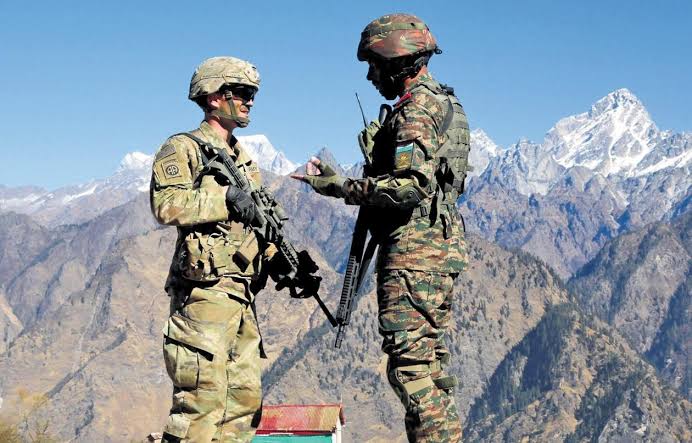In a year marked by bitter conflicts and geopolitical fragmentation, India focused on enhancing military prowess by massively strengthening defense procurement worth Rs 4.22 lakh crore, while Indian and Chinese armies engaged in a standoff at border points in eastern Ladakh. Completed the task of withdrawing his troops from.
Bilateral relations were boosted by the withdrawal of frontline forces at the last two friction points of Demchok and Depsang along the Line of Actual Control (LAC) following an agreement on October 21, four years after deadly clashes between troops of the two countries in the Galwan Valley. I have softened a lot.
At the same time, the Indian Army, guarding the approximately 3,500 km long Line of Actual Control, has maintained an aggressive stance, and has deployed its overall surveillance mechanism to closely monitor the activities of the People’s Liberation Army (PLA) on the Chinese side of the actual border. Have strengthened.
This year India expanded its strategic strength in the key maritime domain, with the Indian Navy deploying more than 30 ships to deal with Houthi militants, who have been carrying out drone and missile attacks on a large number of cargo ships in and around the Red Sea. Were staying.
According to official data, the Indian Navy responded to more than 25 such incidents and rescued more than 230 merchant vessels carrying approximately 90 lakh metric tonnes of cargo worth more than US$4 billion.
The Defense Ministry said in its year-end review that the Indian Navy’s prompt action saved more than 400 lives. India leveraged its strategic strength in key waterways and firmly established its influence over the Indian Ocean against the backdrop of China’s relentless efforts to increase its presence in the region.
While national security planners focused on formulating innovative policies taking lessons from conflicts and tensions in different geographical regions around the world, the armed forces focused on enhancing combat prowess through the procurement of new military hardware and technologies .
The Defense Acquisition Council (DAC) and the Defense Procurement Board (DPB) have provided Approval of Requirement (AoN) for 40 capital acquisition proposals worth Rs 4,22,129 crore in 2024 (till November), the Defense Ministry said in its year-end report. of.
Of these, AON worth Rs 3,97,584 crore (94.19 per cent) has been given for procurement from indigenous sources. Over the past few years, the government has been focusing on promoting domestic defense manufacturing through a series of policy initiatives.
The main focus of the government was on developing indigenous military hardware to deal with future national security challenges. However, the government’s ambitious plan towards theaterisation to bring about better coordination between the Army, Navy and Air Force did not gain much momentum.
In October, Prime Minister Narendra Modi inaugurated the Tata Aircraft Complex for the production of C-295 transport aircraft for the Indian Air Force (IAF). The Indian Air Force is getting 56 C-295 transport aircraft under a pre-arranged deal worth Rs 21,935 crore.
Forty of these aircraft will be made in India. The first domestically produced C-295 aircraft is expected to be delivered in 2026. Another important milestone in enhancing India’s military power was the induction of indigenously built Arihant class nuclear powered submarine ‘INS Arighat’ into the Indian Navy on August 29.
The government has also approved the construction of two indigenously designed nuclear attack submarines. In another move, India signed a mega deal with the US in October to purchase 31 Predator long-endurance drones from US defense major General Atomics under the Foreign Military Sales route. The cost of this deal is about 4 billion US dollars, so that the combat capability of the Indian Army can be increased.
India is mainly purchasing drones to enhance surveillance of the armed forces, especially along the disputed border with China. These high-altitude drones are capable of staying in the air for more than 35 hours and can carry four Hellfire missiles and about 450 kg of bombs.
Indian Navy’s Russian-built guided missile frigate INS Tushil was commissioned into the Navy in the Russian coastal city of Kaliningrad this month. In 2024, the Indian Light Tank (ILT) ‘Zorawar’ achieved a major feat as it fired multiple rounds at various ranges at altitudes of over 4200 meters with consistently accurate results.
This year India also successfully tested several major missiles and other weapon systems.
In November India tested a nuclear capable ballistic missile called K-4 which has a range of about 3,500 kilometers. It was tested from a nuclear powered submarine in the Bay of Bengal. With this test, India has become part of a small group of countries which have the capability to fire nuclear missiles from land, air and underwater.
In the same month, India successfully tested a long-range hypersonic missile. This test was seen as a major achievement because very few countries have this weapon system.
Typically, hypersonic missiles capable of carrying conventional explosives or nuclear warheads can fly at five times the speed of sound at sea level (Mach 5, which is approximately 1,220 km/h).
The Indian Army also focused on incorporating critical technologies such as Artificial Intelligence and Quantum Computing to adapt to the changing nature of warfare. In 2023-2024, India’s defense production to reach a record high of Rs 1,26,887 crore, showing a growth of 16.7 per cent over the previous financial year.
Similarly, defense exports reached a record Rs 21,083 crore in 2023-24, up 32.5 per cent from the previous fiscal, when it stood at Rs 15,920 crore.
In July, the government had earmarked Rs 6.22 lakh crore as defense outlay for 2024-25. Of the total allocation, Rs 1.72 lakh crore was earmarked for capital expenditure, which largely includes buying new weapons, aircraft, warships and other military hardware.
The Indian Armed Forces also participated in several major war exercises and conducted several of them throughout the year.
The most notable of these was the Malabar exercise involving the navies of India, the US, Australia and Japan. India had hosted the Malabar exercise in October which included both maritime and port phases and was aimed at enhancing cooperation in the Indo-Pacific region.
Various major naval platforms from the participating countries participated in the exercise, including guided missile destroyers, multi-role frigates, submarines, fighter aircraft and helicopters.
The Indian Navy has had to deal with several major accidents. In July, the frontline warship INS Brahmaputra was badly damaged in a massive fire. At least 13 people were killed in a collision between a passenger ferry and a Navy speedboat in Mumbai this month.
All three services will also get new chiefs in 2024. In April, Admiral Dinesh Kumar Tripathi, a communications and electronic warfare expert, became the 26th Navy Chief after R Hari Kumar retired from the service.
In June General Upendra Dwivedi, who has extensive operational experience along the borders with China and Pakistan, took over as the 30th Army Chief, replacing General Manoj Pandey. Air Chief Marshal Amar Preet Singh took over as the Chief of the Indian Air Force in September, succeeding Air Chief Marshal V R Choudhary.









